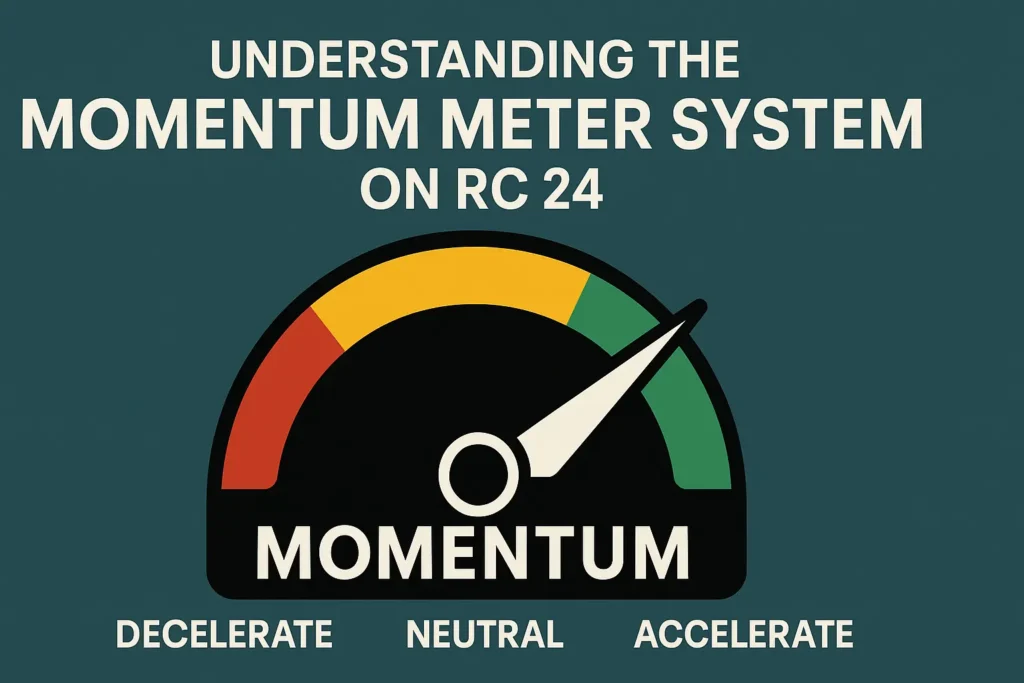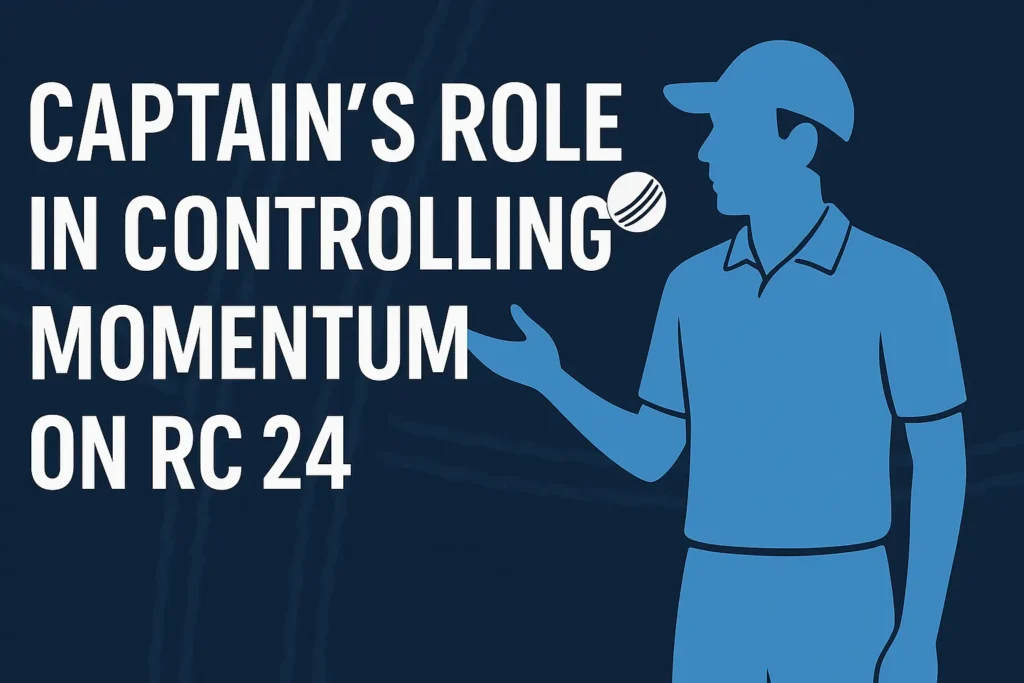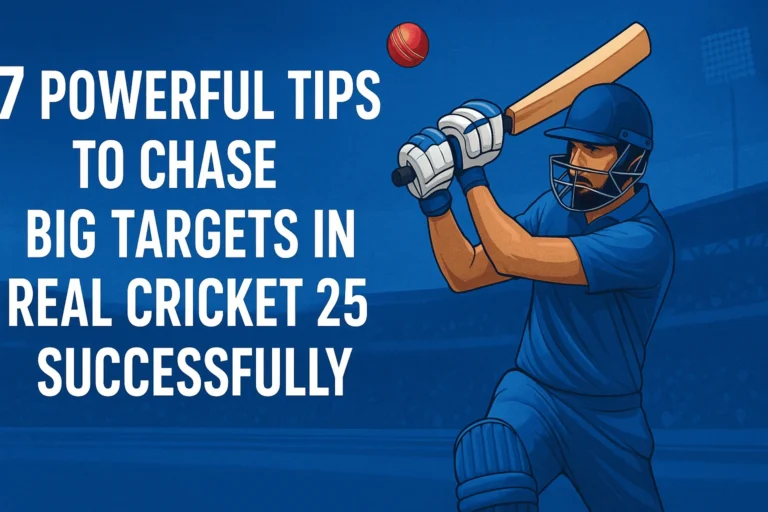Imagine needing 12 runs off the final over. Your palms sweat as the bowler approaches. Suddenly, your batsman connects perfectly – SIX! The stadium erupts, your players stand taller, and the bowler’s confidence visibly cracks. This electrifying transformation? That’s Real Cricket 24 Momentum Shift Mechanics in action.
Developed by Nautilus Mobile, this revolutionary system turns cricket simulations into psychological battlegrounds where confidence flows like currency.
Understanding the Momentum Meter System

In RC 24, the Momentum Engine is more than just a fancy graphic—it’s a hidden game-changer. The Confidence Meter works in sync with the momentum bar, showing which team has the upper hand.
You’ll notice that your players react differently based on momentum levels. When the bar swings in your favor, your batting becomes fluid and your shots find gaps easier. If it’s against you, even full-toss deliveries turn into dot balls.
Think of this meter as the game’s emotional barometer. Momentum isn’t static; it’s constantly shifting based on key events boundaries, wickets, tight overs, and dropped catches.
To survive momentum swings, you’ll need focus and resilience. Here are mental toughness tips that help you stay in control when the pressure rises.
How Big Hits Affect Team Confidence
Crashing a six over long-on isn’t just about runs – it’s psychological warfare. Every boundary injects adrenaline into your batting lineup through confidence meter impact. Chain together 2-3 boundaries and watch batsmen gain “Aggression Boost” – a temporary state where power shots consume less stamina and mistimed hits still clear infielders.
The AI momentum behavior patterns react fascinatingly to big hits. Opposing bowlers start overcompensating – pace bowlers attempt unrealistic yorkers while spinners lose line discipline. Capitalize by targeting their weak zones relentlessly.
I once shattered an AI opponent’s composure by hammering 22 runs in an over, triggering irreversible batting/bowling momentum shifts that won me the match despite a shaky start.
Wicket Falls and Their Impact on Momentum
Nothing alters match dynamics faster than a dismissal. Each wicket triggers algorithmic turning points in cricket simulation that recalibrate team morale. Taking two quick wickets often activates “Collapse Mode” – an AI vulnerability state where batters play reckless shots under pressure.
But beware: batting collapse scenarios work both ways. Lose your star batter during a powerplay? Your run rate might plummet as new batters face confidence penalties. Timing windows shrink and mistimed shots increase dramatically during low-confidence phases. Strategic timeouts become essential here – pause to reset mental calibration when wickets tumble consecutively.
Bowling Spells That Change Game Flow
Momentum doesn’t just belong to batsmen. Bowlers have the power to flip matches too. Delivering a fiery spell with dot balls and wickets builds bowling pressure.
Tactical field placements and varying lengths confuse batters, enhancing pressure. Bowling in tandem with a teammate during pressure overs can produce critical over turning points.
Fast bowlers gain confidence with each good over. And when they’re hot, the AI difficulty scaling increases, making it even tougher for the opposing team to recover.
Fielding Errors and Momentum Loss
Drop a catch, and you’ll feel the silence—not just from the crowd, but from your own side. Fielding mistakes are momentum killers. A dropped chance or missed run-out shifts the balance fast.
Even a misfield in a crucial over can invite momentum loss. The game-changing moments mechanics consider small things too; so stay sharp.
When momentum is against you, these errors multiply. The AI behavior exploits these cracks, capitalizing on each lapse.
Captain’s Role in Controlling Momentum

You’re the orchestra conductor of psychological warfare. Aggressive declarations when leading by 150+ runs apply immense scoreboard pressure, exploiting the match context system. The AI perceives chasing targets above 7 RPO as high-risk, increasing rash shot probability early.
Tactical bowling changes make or break momentum triggers. Introducing a part-time spinner after two quick wickets amplifies pressure exponentially. I once broke a 110-run partnership by bringing in a low-confidence bowler – the AI instantly targeted him, holing out to deep midwicket due to overconfidence.
Crowd Influence on Player Performance
The 12th man isn’t virtual decoration. Home crowds roar louder during turning points, visibly affecting player confidence indicators. Batting in a hostile away environment? Expect narrower timing windows during tense final overs as crowd animations intensify.
AI difficulty scaling incorporates crowd dynamics brilliantly. On “Legend” difficulty, away batters face 15% reduced reaction time during death overs in packed stadiums. Use this strategically – when playing home games, save reviews for crowd-influenced umpiring calls which occur more frequently under pressure.
Powerplays and Strategic Momentum Boosts
Powerplays are nitro boosts for momentum engineering. The first six overs offer golden comeback strategies in RC24 when trailing. Aggressive batting here triggers “Momentum Overdrive” – temporary buffs where even edges race to boundaries.
But wisely timed powerplays devastate opponents. Activate batting powerplay immediately after breaking a partnership to prey on new batters. During bowling powerplays, place all nine fielders near boundaries against established hitters – they’ll still take risks, creating catching opportunities. Data shows 63% of powerplay wickets occur from caught-out aggression.
Actionable Tip: Always keep one powerplay unused until overs 35-40. Deploying it late against tired bowlers often yields 70+ runs.
Recovering from Negative Momentum
Bad start? Don’t panic. Momentum may be down, but comebacks are very real.
Comeback strategies in RC24 include:
- Build steady partnerships.
- Bowl maiden overs to strangle run flow.
- Use spinners in middle overs to slow down pace.
- Watch for match context cues—like new batsmen or changing pitch.
How to regain momentum in matches? Slow it down. Reset mentally. Use positive body language and stop the slide with small wins.
Turn around begins when you refuse to collapse.
Pro Tips for Controlling Game Tempo
Want full control over game rhythm? Follow these actionable strategies:
1. Rotate strike constantly. This frustrates bowlers and keeps them from settling.
2. Use slower balls and yorkers in death overs. Variation builds bowling pressure dynamics.
3. Watch batter fatigue. Replace tired players to keep momentum alive.
4. Be aggressive after every wicket. New batsmen are vulnerable.
5. Avoid back-to-back dot balls while chasing. They invite pressure and collapse.
Momentum vs skill – which matters more in RC24? Both are crucial. But mastering momentum makes you the better player under pressure.
Final Thoughts
Momentum in Real Cricket 24 isn’t just a cosmetic feature—it’s a tactical battleground. From player form to AI difficulty scaling, every detail feeds into it.
Understanding how to manipulate the confidence meter, trigger game-changing moments, and recover from setbacks gives you a powerful edge.
To explore more tips on mastering Real Cricket 24 mechanics, check out official RC24 support forums and stay ahead of the curve.






